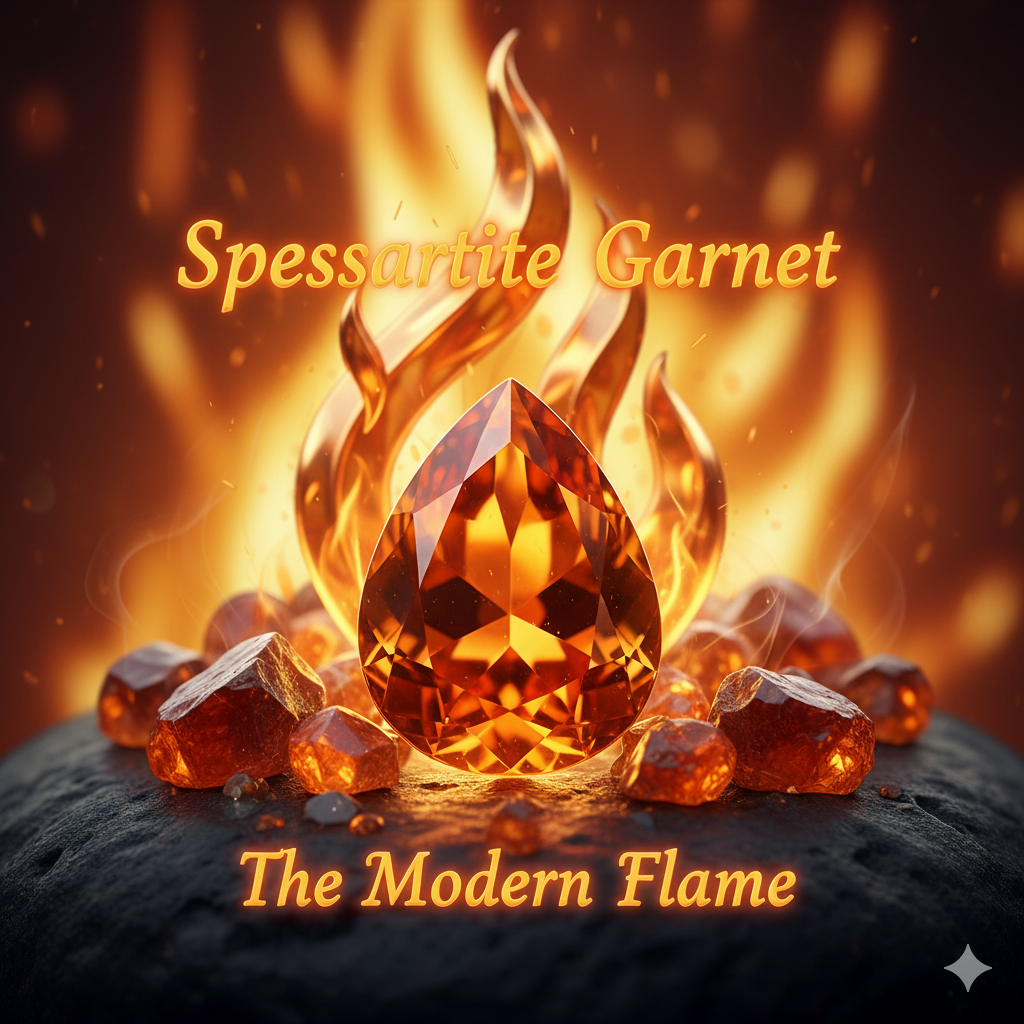Introduction
1) The Colour That Refused to Be Ordinary
In a world of rubies and sapphires — predictable, pedigreed — Spessartite Garnet arrived like a beautiful interruption.
It wasn’t crimson, it wasn’t gold, and it wasn’t trying to be either.
It was sunlight, distilled.
The first time a collector sees one, they pause.
It glows not like a fire, but like the memory of one — soft, intelligent, almost liquid.
That hue — orange with whispers of amber and honey — has become the quiet new obsession of connoisseurs and designers alike.
In a culture that celebrates extremes, Spessartite speaks a different language: confidence without shout, light without apology.
2) A Gem for the New Decade
Every era has a colour that defines its luxury.
The 1990s belonged to pink sapphire, the 2000s to blue topaz, the 2010s to morganite and rose gold.
The 2020s belong to orange — not neon orange, but the golden-orange that suggests creativity, individuality, and courage with warmth.
Spessartite sits at the centre of that spectrum.
It’s vibrant yet sophisticated — the perfect gem for a world that craves optimism with depth.
Where ruby says power, and sapphire says authority, Spessartite says presence.
3) From Bavarian Mountains to African Sunlight
The name Spessartite comes from the Spessart Mountains in Bavaria, Germany, where it was first discovered in the early 1800s.
But its modern fame began much later — in the 1980s and 1990s, when new deposits in Nigeria and Namibia unveiled stones of unparalleled colour and clarity.
African Spessartites were electric — glowing like molten glass.
They carried transparency and life unseen in earlier finds.
The finest, from the Namibian mines near Marienfluss and Kunene, radiated a colour that gem dealers began calling Mandarin Garnet.
These were not just garnets; they were bottled sunlight.
4) The Chemistry of Colour
Spessartite belongs to the garnet group but is chemically distinct — a manganese-aluminium silicate (Mn₃Al₂Si₃O₁₂).
The manganese gives it that unmistakable orange hue — from golden amber to deep tangerine.
Trace amounts of iron can deepen it toward reddish orange, while absolute purity produces that sought-after Mandarin glow.
Its refractive index (1.79–1.81) gives it brilliance comparable to ruby, but its higher dispersion — the ability to split light into rainbow flashes — makes it livelier, almost cinematic.
When well-cut, a Spessartite seems to glow from within, as though it doesn’t reflect light — it remembers it.
5) The Aesthetic of Bold Warmth
Designers adore Spessartite because it pairs emotion with strength.
It looks spectacular in yellow or rose gold, stunning in contrast with white diamonds, and almost surreal beside blue sapphires.
Contemporary houses like Pomellato, Bulgari, and Dior Joaillerie have quietly begun reviving Spessartite in statement rings and modern cocktail pieces — not as centre-stage bling, but as intellectual colour.
Where traditional gems appeal to nostalgia, Spessartite appeals to curiosity.
It’s the gemstone for those who want to wear warmth as sophistication.
6) The Modern Collector’s Darling
In the collector world, Spessartite is now entering its golden era.
Natural, untreated stones of fine colour and clarity are becoming increasingly rare, especially above 5 carats.
African material has been largely mined out, and most new finds show darker tones or inclusions.
This rarity, combined with its unmatched saturation, has made Spessartite a modern investment gem — still accessible, but climbing fast.
Dealers often call it “the last undervalued precious colour.”
7) Light as Personality
Unlike rubies or spinels, Spessartite doesn’t demand attention — it seduces it.
Its brilliance is playful; it moves like flame across facets.
Under sunlight, it radiates orange with flashes of gold; under candlelight, it deepens to copper and whiskey.
Every shift of illumination rewrites its personality.
This dynamic glow — cinematic warmth — is why photographers and jewelry stylists love working with it.
It performs beautifully on skin, especially warm or olive tones, and carries emotional generosity even in minimalist settings.
8) How It’s Set — Modern Interpretations
Modern Milanese and Parisian designers treat Spessartite as an architectural colour.
Instead of hiding it behind halos or pavé, they let it breathe — single stones, bezel-set, bold geometry.
-
Pomellato uses mandarin garnets in sculpted domes.
-
Buccellati pairs them with hand-engraved gold, creating ancient warmth.
-
Suzanne Kalan frames them with asymmetric diamond bursts, modern and kinetic.
The result is jewelry that feels confident yet kind — light you can wear every day.
9) The Emotional Symbolism
Orange gemstones have long symbolized creativity, confidence, and renewal.
In many cultures, orange represents spiritual joy — the balance between passion (red) and wisdom (yellow).
Wearing Spessartite feels like standing in a late-afternoon sunbeam — uplifting, dignified, unhurried.
It carries no aggression, no pretense — just radiance, pure and sincere.
In the PreciousCarats philosophy, this is the gem for those who live with quiet fire — people who don’t need to prove they shine.
10) The Spessartite vs. Other Garnets
| Type | Colour | Origin | Character |
|---|---|---|---|
| Almandine | Deep red | India, Sri Lanka | Earthy, classic |
| Pyrope | Crimson | Mozambique, Madagascar | Romantic, warm |
| Grossular (Tsavorite) | Green | Kenya, Tanzania | Lush, lively |
| Spessartite | Orange | Namibia, Nigeria | Energetic, elegant |
It’s the most modern of all garnets — bright, optimistic, unapologetically contemporary.
11) On the Skin — A Dialogue with Light
Jewelry photographers often say Spessartite doesn’t sit on the skin; it merges with it.
Its tone harmonizes with human warmth, enhancing complexion instead of competing with it.
That’s why stylists prefer it for gold-based designs and natural-light shoots — it feels human, not cosmetic.
On fair skin, it glows like sunset; on deeper tones, it gleams like embers.
12) Caring for the Flame
With a hardness of 7–7.5 on the Mohs scale, Spessartite is durable enough for daily wear but still appreciates care.
Avoid ultrasonic cleaners and sharp temperature shifts.
A soft brush, mild soap, and warm water preserve its lustre.
Unlike many gems, Spessartite is almost always untreated — nature’s work left untouched.
13) Famous Spessartites
While not as publicized as rubies or sapphires, Spessartite has appeared in some remarkable collections:
-
The Mandarin Garnet Necklace by Tiffany & Co. — an ode to modern sunlight.
-
Oscar Heyman’s fireburst rings, pairing mandarin garnets with canary diamonds.
-
Private high jewelry commissions by Dior and Bvlgari, where the gem acts as the “warm heart” of avant-garde designs.
Each piece proves the same point: Spessartite doesn’t imitate; it inspires.
14) PreciousCarats Reflection — Light with Personality
For PreciousCarats, Spessartite represents a new kind of luxury — one rooted in emotion, individuality, and the courage to glow differently.
It’s for the customer who doesn’t chase pedigree but resonance — someone who knows that colour, like character, can’t be mass-produced.
We curate Spessartites not for rarity alone, but for temperament — the way each stone seems to hum with light, as though remembering every sunrise it’s seen.
15) Closing — The New Colour of Confidence
If gemstones were moods, Spessartite would be joy made tangible.
Not the loud joy of celebration — the quiet one of belonging, of knowing you’ve found your light.
It’s the hue of golden-hour certainty, of confidence without armour.
A gem for those who don’t ask to be noticed — they simply warm the room.
Spessartite doesn’t burn. It glows.
And in that glow, the modern world finds its new fire.

